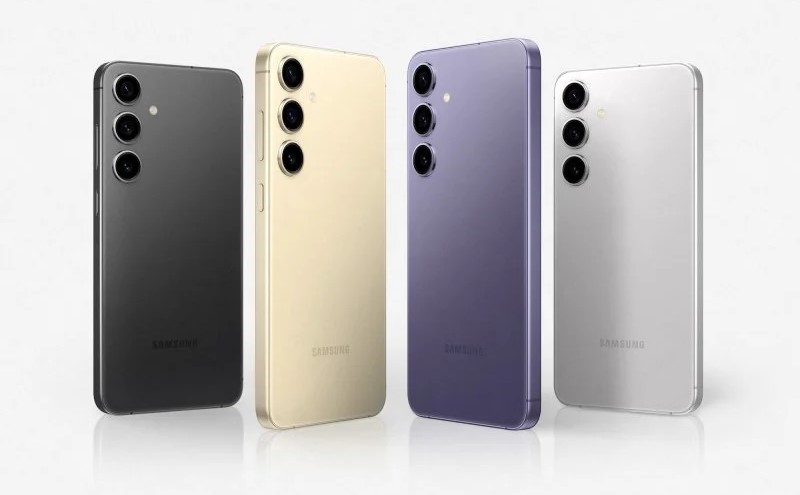Galaxy S24 series launched at the start of the year, and this year, as usual, there are three phones – S24, S24 Plus and S24 Ultra. What is unusual, though, are the much-needed upgrades on the Samsung Galaxy S24 Plus. For years, the Galaxy S series Plus phone has been nothing more than a larger base S series model with significant misses compared to the Ultra. This year, Samsung has evolved its game to the S tier with the new Samsung Galaxy S24 Plus.
Design
Visually, the Samsung Galaxy S24 Plus looks similar to its predecessor. The rear panel is still a colourful frost glass matching similar coloured flat metal sides with three similar camera islands at its rear. Banking on the display prowess this time around, the Samsung Galaxy S24 Plus brings a larger display in the same chassis as last year. This time, there is a 6.8-inch display with symmetrical minimal bezels all around. Samsung is simply following the quote: if it ain’t broke, don’t fix it. The design is tried and tested, minimalistically stunning and well-designed with good weight balance. IP68 ratings and gorilla glass Victus ensure protection is top-tier, too.
Display
A major upgrade to this year’s Galaxy S24 Plus is the inclusion of a QHD+ 120Hz LTPO AMOLED 6.8-inch display. The resolution, peak brightness of 2600nits on HDR content and the PPI count are ironically a little better than its elder sibling, the Samsung Galaxy S24 Ultra. The added resolution and brightness finally make the Galaxy S24 Plus feel like a worthy large flagship phone.
Performance
Performance in the current era of smartphones depends on two major factors – hardware and software. On the hardware side, Samsung has opted for the Exynos 2400, a 4nm SOC with 10 cores. Matching this performance is the 12GB RAM from the base variant with the capability to extend RAM when possible. Together with the better hardware performance comes an Android 14-based One UI software which is loaded pack with Galaxy AI, a version of implementing Google Gemini Pro on the Samsung S series. Samsung plans to bring Galaxy AI features to the S23 series too. Needless to say, the new chip performs like a flagship processor, and although it might fall on sheer benchmarking numbers compared to the Snapdragon 8 Gen 3, the Exynos 2400 holds its own, delivering snappy performance coupled with decent battery life.
Circle to search, live translate, and more AI features work seamlessly, if not perfectly and add a sense of software newness to the entire experience. There are tons of customisations, WiFi 6E and Bluetooth 5.3 support for multi-channel audio, calling, texting and gaming on this phone has been a charm. No matter what task is thrown at the phone, including some demanding games like GTA San Andreas, Genshin Impact, and Raji, the S24 Plus gamed like a console. The back did feel warm after an hour of gaming but nothing alarming. Samsung is promising 7 years of OS and security updates with the S24 Plus, and we believe the phone will stand the test of time, albeit with a battery replacement.
Camera
If it ain’t broke, don’t fix it. The camera system is the same as last year, which was the same as yesteryear. Samsung has not changed the hardware on the S Plus series since S22! The 50MP primary shooter does a commendable job with auto HDR, the 12MP ultrawide camera still maintains the details and colour science of the primary camera, and the 3x telephoto camera matches the performance overall. The primary camera can shoot 8K footage while all others can do 4K 60fps. The pictures are similar to the S23 series and maintain similar depth of contrast, crispness, saturation and contrast. The selfie camera is similar too. Overall, the tried and tested camera setup is here to stay this year and 9/10 times clicks images and videos worth saving.
What is interestingly noteworthy about S24 Plus is the new image editor and enhancement tools, which are similar to the Pixel 8 pro series. The ability to create slow-motion videos out of regular videos, edit images with a simple AI-generated tap and more make this camera setup feel more usable and creatively user-friendly. Samsung has also enabled apps like Instagram and Snapchat to access their hardware and software camera features, ensuring crisp social media integration.
Battery life and Verdict
With a healthy 4900mAh battery and the capabilities of 45W fast charge, fast wireless charging and reverse wireless charging, the Samsung Galaxy S24 Plus covers all the flagship checkmarks. The Exynos 2400 was performing below average, but a quick software update fixed the issue, and now, it has been consistently delivering above-average battery life. A day’s heavy use or two days of medium usage are sustainable on the S24 Plus.
Samsung has finally added value to the Plus category with a crisper display, better hardware, and, overall, one of the best software implementations and improvements on any series of smartphones. With the Pixel-esque image editing features, the immense capabilities of Galaxy AI powered by Google Gemini Pro and the utmost peace of mind with over half a dozen years of software support, the Samsung Galaxy S24 Plus is almost an Ultra smartphone without the S-Pen or that the multi-digit price tag. We absolutely recommend this year’s Galaxy S24 Plus for a premium large flagship Android experience.
Galaxy S24 Plus Specs
6.8-inch QHD+ LTPO AMOLED
Exynos 2400
12GB RAM + Expandable
Android 14 + One UI + Galaxy AI
INR 99,999
